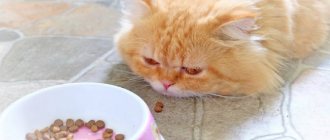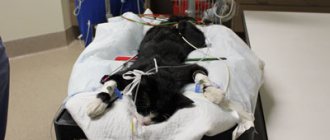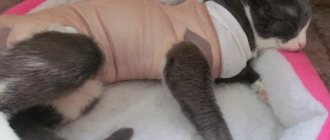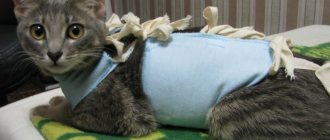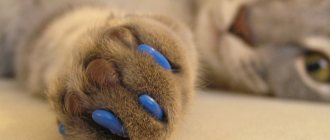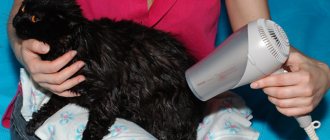After surgery (for example, after neutering or abdominal manipulation), a post-operative cat bandage or blanket may be needed.
Cats also wear it to protect the remaining sutures on the abdomen after surgical excision (surgery of the intestines, stomach). A postoperative bandage is a pressure cover placed on the animal’s torso, which covers the suture and wound in the abdominal cavity. Its use prevents the proliferation of microorganisms in the postoperative area. The bandage prevents the cat from licking stitches and wounds (healing and regeneration in the area closed to the tongue occurs faster). In addition, pathogenic microorganisms and bacteria do not enter this area.
Buy a blanket or collar in the online store =>>
Why do you need a blanket?
blanket (bandage) – a fabric covering prescribed for cats to wear after surgery
Veterinarians everywhere prescribe so-called blankets for cats during the postoperative period. A blanket, also known as a bandage, is a fabric covering that covers the entire abdomen and chest of a pet, thus preventing the animal from reaching postoperative sutures. The need for it is due to the fact that cats often not only actively lick the stitches, but also try to chew out medical threads on the incisions. And since in most cases the sutures need to be treated with medications several times a day, at least in the first days after surgery, and ingestion of such medications by animals is undesirable, the bandage also helps protect the cat from poisoning with antiseptics.
Depending on the nature of the operation, a blanket can be put on the animal in a veterinary clinic, or its wearing is prescribed as necessary, so owners must clearly understand not only how to put a bandage on their pet, but also what to use when choosing it.
Buy or make it yourself
When the need for a postoperative blanket arises, the owner is faced with a choice: purchase the product in a store or make it himself. Each option has its pros and cons.
Advantages of factory products:
- made in compliance with all standards, from environmentally friendly materials;
- high quality, have sufficient strength, the ties do not come off, the edges do not fray;
- special medical breathable fabrics are used for production;
- the design of the blanket fully corresponds to the anatomical structure of the cat;
- Convenient Velcro fasteners are often found.
Pros of homemade blankets:
- a bandage tailored to the animal’s individual measurements will fit perfectly and be more comfortable;
- using a pattern made once, you can sew the required number of replacement bandages;
- Considering that a blanket can be made from scrap materials or sewn from old clothes, it will not require material costs.
Expert opinion
Irgutanova Nina Nikolaevna
Practicing veterinarian, 13 years of experience.
Considering the low cost of ready-made blankets, you can purchase one, and then compare it with a homemade one in terms of convenience for the cat, and after that choose the most suitable option. Moreover, in almost all clinics the cost of the operation already includes at least one bandage.
How to choose a device
choose products in transparent packaging, study in detail the quality factor of the bandage
For a speedy recovery of your pet, it is important that the blanket meets a number of requirements:
- Materials. It is better to opt for natural cotton products, so air will easily flow to the wound, which reduces the risk of inflammatory processes and suppuration. The ideal materials for a bandage would be a combination of cotton and lycra, but the inclusion of synthetic fibers will not negatively affect the quality, but on the contrary - it improves the stretchability of the fabric and does not hinder the animal’s movements.
- Quality of tailoring. All seams of the device should be strong, but be neat so that the cat cannot tear them in an attempt to get rid of the bandage. Even numerous ties of the product should have a stitch around the perimeter. This will extend the service life during subsequent washes and prevent “fraying”. After all, even a small thread getting on a healing wound can result in rotting of the seam and a deterioration in your pet’s well-being.
- Selected size. Mass produced blankets come in three sizes: S (for small cats), M (for medium cats) and L (for large cats). Given your pet's individual characteristics, choosing the perfect bandage for her may not be easy. In this case, the blanket can be sewn by hand.
- Colors. On a light-colored or plain product, various stains will immediately catch your eye, which means they will be a signal to you that the blanket needs to be washed.
- Package. Keep in mind that in a pet store you are unlikely to be allowed to take the blanket out of the package and try it on the animal. You can only visually, through the package, evaluate the quality of tailoring of the bandage. Therefore, choose a product in transparent packaging; unfortunately, unscrupulous, low-quality products are packaged with a bright design.
What to replace it with?
If a person is not good at sewing, then for such work he will need children's clothing in the form of a bodysuit. You can make a blanket from scrap materials. If the animal is small, a belt made from a sock will do.
It is important to remember that the sock must be completely new and never used. Slots are made in the designated places through which the paw can be inserted
However, such a blanket is unreliable because it can be easily removed. For an adult cat, a blanket made from tights is suitable. It is important that the product has increased density. In addition to tights, you can use a pant leg or sleeve cut off from unnecessary clothing. As in the version with a sock, holes for the limbs are cut in the required places. A good option that replaces the cat wrap is a baby bodysuit.
Instructions for putting on
most often the blanket is put on the cat right in the veterinary clinic
Most often, the blanket is fixed to the cat’s body using ties, but there are also options on sale with Velcro and zippers. It is easier to dress an animal in a bandage with Velcro or a zipper, but such products are usually much more expensive.
As you already know, most often a blanket is put on a cat right in the veterinary clinic; in most cases, at this time the animal is still under anesthesia or only partially conscious. In this state, the purr offers no resistance, which greatly simplifies the task. If difficulties arise, seek help from the veterinary clinic staff. Now the main thing for you is not to make sudden movements when manipulating the animal’s body, be extremely careful - fresh stitches are very easy to damage!
Subsequent times, when removing and putting on the bandage to treat the wound, you will have to deal with an active animal. It is important to act as calmly as possible. If your pet is noticeably nervous, try to calm him down with petting and a gentle voice.
Terms of use
The animal's sutures must be periodically washed and treated during the postoperative period. In the process of performing such actions, the blanket does not need to be completely removed. Only the bottom pair of ribbons is untied. The product must adhere firmly to the cat.
If the bandage is dirty or has strong discharge, it is removed and replaced with a new one. Blankets should be changed regularly to minimize the risk of rotting and wound infection.
The product is completely removed only at the discretion of the veterinarian. If the blanket was made correctly and used correctly, it will ensure a quick recovery for the cat.
Rules for tying on an animal
scheme for attaching a blanket to a cat
Let's focus on how you can put a blanket on a cat. First, make sure that the bandage is positioned correctly on the table, the reference points are symmetrical cutouts for the front legs. The cat's head should be slightly in front of them, and the cutouts themselves should be in the area of your pet's front armpits.
A standard blanket has 7 pairs of laces for fixation, symmetrically located along the side edges of the product. They have to be tied on the back of the animal. Considering that you will often have to remove and put on the bandage, you should not make the knots too tight. However, too weak a fixation can create problems: the cat will be able to untie the laces with its teeth and get rid of the bandage.
- You need to tie the blanket correctly starting from the head. Taking the two laces at the front, fix them on the purr's neck.
- The next two pairs of ribbons need to be tied crosswise on the animal’s shoulder blades, that is, the right tie from the third pair is connected to the left tie from the second pair, the right tie from the second pair is connected to the left tie from the third pair. So you should get a crosshair made of ribbons on your pet’s withers.
- The following laces are tied in pairs on the back.
- The last two pairs of ties should be secured crosswise on the back of the animal's body.
When fixing the blanket, do not squeeze the animal’s body too much. If you notice that the cat's movements have become constrained, slightly loosen the lacing. Also make sure that the bandage does not cover the animal’s excretory openings: the anus and urinary tract. Otherwise, due to discomfort, the animal will try to remove the post-operative bandage, and you will be faced with the fact that the blanket will very soon be dirty.
If the wound on your pet’s body is small, it is not necessary to completely remove the blanket to treat it - free only that part of the body where the surgical suture is located, this way you will save your time and your pet’s nerves in the process of fixing the bandage. When tying ribbons, do not leave long ends. Remember that your cat can easily pull them with his teeth, loosening or untying the knot.
It is allowed to remove the bandage for 15-20 minutes 2-3 times a day, especially if the cat does not get used to it well. However, at this time the pet should be under your close attention. When trying to lick stitches and wounds, you must immediately gently prevent this: caress the animal or distract it with food.
It's best to have another blanket just in case. You should not rule out the possibility that your pet may tear the bandage with its teeth or get it very dirty, in which case it will be necessary to replace the bandage.
Choosing a sanitary dressing
You need to take care of protective equipment for your pet in advance, even before the scheduled operation. Then your pet will quickly get used to the medical gown, and wearing it after sterilization will not aggravate the stressful condition. Prepare at least two hygiene items to replace it after it gets dirty. When purchasing a product, pay attention to its appearance and fabric composition.
Material
Medical blankets in pharmacies at veterinary hospitals are usually made of non-woven fabric. This base does not contain lint and does not crumble if you need to trim the product to make it more comfortable for the animal. The pressed fibers perfectly absorb liquid, keeping the surface of the wound dry. Another advantage of such a base is its resistance to tearing by claws, as well as a long service life. The product can withstand repeated washing and does not affect your pet's skin.
Factory blankets are sewn from different fabrics:
- cotton;
- viscose;
- spunbond;
- meltblown.
To ensure free access of air to the wound, material made from natural threads is preferable. Foreign manufacturers often use a cotton-lycra blend to give the product stretch. In this case, the fabric limits freedom of movement less.
Size
Before purchasing a product, you need to weigh the animal, and also determine the circumference of the chest (behind the front legs). The length of a large bandage will be 7 cm longer. If the bandage is chosen correctly, then the width of the open part of the pet’s back is no more than 8–9 cm . The volume of the product is easy to adjust with ties, but the size remains unchanged.
Factories usually sew post-operative blankets for adult cats weighing 3–5 kg. Finding a protective device for a kitten is more difficult. For him, the size of the product along the length of the body from the base of the neck to the beginning of the tail will be 28 cm, and the model range starts from 38 cm with a chest circumference of 31 cm. Large animals with a body weight of 6–10 kg will be suitable for a protective bandage with dimensions of 42x35 cm.
Model type
There are several types of medical blankets for cats. They differ in the processing of the holes for the paws and the way the bandage is secured to the animal. A one-piece product with slits is less common than a coverlet that covers the limbs. The sleeveless robe is trimmed with a durable piping that covers all the edges and prevents the fabric from fraying.
A blanket with cutouts for cat paws is used in the treatment of back wounds
Most post-surgical blankets are secured to the pet's back with 6-7 pairs of ribbons. Bandages with Velcro fastening are much easier to use . The wide apron can be easily removed if necessary. On an individual order, the tailor can improve the fastening by replacing part of the ties with a zipper braid.
There are also expensive models with push-button clasps on sale. They are located on both sides near the animal's neck. Dutch manufacturers have equipped the hygiene product with an internal pocket. A bandage with medicine is placed there.
How many days to wear
in the question of how long to continue wearing the bandage, trust your veterinarian.
Postoperative care, which is fully the responsibility of the owners, is one of the most important points, for example, when sterilizing a cat. One of the most frequently asked questions is how long should I wear a blanket?
It is important to understand here that the duration of wearing the bandage directly depends on the complexity of the operation, the size of the wound, the individual condition of the cat and the healing processes. As a rule, after simple surgical interventions, the pet should wear a bandage for 10 to 15 days. However, these terms may vary either more or less.
The problem that you may encounter is that the cat may resist putting on and wearing the blanket, trying with all its might to remove it. Often the pet looks unhappy or is offended by the owners, so there may be a desire to rid the animal of wearing a bandage early. But it is important to remember that the optimal timing for removing the bandage will save your pet from unnecessary problems, and the decision to finally abandon the blanket should be made by a veterinarian.
Warm
Cats, which are representatives of hairless breeds, often freeze when there are cold seasons outside the window. This not only causes significant discomfort for pets, but can also lead to the development of colds. In such circumstances, a special warm blanket would be an excellent solution.
Most often, caring owners of Sphynxes and Cornish Rexes turn to such things. These types of blankets look like simple sleeveless vests.
The best and most comfortable blankets are warm blankets made from soft fabric with large pile. Such things effectively protect hairless or short-haired cats from low temperatures and cold gusts of wind. Even during a walk, your pet will be warm and comfortable in a cozy blanket.
Separately, it is worth highlighting the knitted woolen blankets that fit the body well. These specimens are especially warm and have an excellent warming effect. They are very comfortable for cats and kittens.
A knitted wool blanket can easily be an excellent replacement for cat fur.
Seam processing
treatment of postoperative sutures is an extremely important point
In addition, you should not miss such an important point as processing the seams. After sterilization, the suture is usually located in the lower abdomen of the animal. In this case, it is better not to remove the bandage completely, so you will save yourself the hassle of putting it on later. It will be enough to untie two or three of the outermost rear laces and bend the edge of the fabric so that it does not interfere with access to the treatment area. Antibacterialization of the wound is carried out with medications prescribed by the veterinarian and at intervals recommended by him, depending on the nature of the medical intervention and the general condition of your pet.
When to remove the blanket?
the period of wearing the bandage also directly depends on the type of suture treatment.
The duration of wearing the bandage also depends on the type of suture treatment used by the operating veterinarian. Was it treated with a special spray that protects the seam from harmful bacteria, or was no such treatment carried out?
In cases with the use of a spray, the likelihood of inflammatory processes is reduced. Provided the pet's condition is satisfactory and there are no complications in the suture area, at the discretion of the veterinarian, the maximum period of wearing the bandage can be a week. If the spray was not used after the operation, surgeons recommend wearing a blanket for ten days to be on the safe side.
As we have already said, the veterinarian should have the final say on removing the bandage. Sometimes the decision that a cat should stop wearing a bandage is made for the following reasons:
- The pet behaves extremely aggressively and does not give up trying to remove the blanket (but in this case, the doctor may also prescribe sedatives to calm the animal).
- The cat does not stand on its paws, is afraid to take even a few steps, or stops eating.
- Clear signs of deterioration in the general condition of the animal (nausea, vomiting, tremors, breathing problems, fever or elevated temperature).
- Scuffs and ulcers where the product comes into contact with the skin.
Is a blanket always necessary?
The need for a blanket primarily depends on the nature of the surgical operation
Answer: not always! For example, after sterilizing a cat using laparoscopy, you can do without a bandage, because in this case there is no suture, and the reproductive organs are removed through a puncture. You can also do without a blanket if the surgeon used subcutaneous sutures. For their speedy healing, it is necessary that the skin is constantly open and “breathing”. The bandage is always put on the animal after sterilization along the white line, after abdominal operations and operations on the mammary glands.
We have already mentioned the owners who do not understand the need to wear a bandage and allow their pet to walk without a blanket. But let's look in detail at what negative consequences early withdrawal threatens.
- Dehiscence of sutures due to licking or gnawing of surgical threads.
- External and internal bleeding.
- Inflammation and suppuration of the wound.
All these troubles can overtake your pet immediately, or over the next few days after the cat is freed from the device that was causing inconvenience. You need to understand that if you allow your pet to walk without a blanket, then you will no longer be able to make claims or count on medical care, which many veterinary clinics provide under warranty.
Briefly about the purpose
We will not consider the options for the mentioned “clothing” only as an interesting addition to the image of a pet, although in some cases a blanket is really needed for practical purposes (for example, for heating short-haired or hairless cats and cats).
Most often, this element of a cat's wardrobe is used to protect the postoperative suture from dirt, pathogens, fungi, and even the tongue of the animal itself, which strives to lick the wound. Inflammation of the suture is one of the most important complications after surgery, so it’s not worth the risk.
Created on a fabric basis and placed on the cat immediately after the procedure, the bandage will block any access to the stitches and facilitate their quick tightening. In many private clinics, it is given to each operated animal at no additional cost, but even if this does not happen, you can purchase a blanket at any specialized store with a large assortment of similar products, or, as a last resort, sew it yourself.
Important! Before looking for a post-operative bandage or making one yourself, check with your veterinarian whether it is necessary to use it, because today there are many suturing technologies, after which a blanket is not required or may even cause harm. There are several types of blankets depending on their purpose - postoperative and protective (warm and waterproof)
There are several types of blankets depending on their purpose - postoperative and protective (warm and waterproof).
In the postoperative period, it is necessary to protect the sutures from licking - cats tend to lick their wounds and chew out surgical threads, which significantly complicates and prolongs the healing period. In addition, the intervention area should not be exposed to dirt and dust, and given that animals actively move around the house and are in the darkest corners, this can be difficult. A special postoperative blanket solves the described problems. It is worth acquiring if the following interventions have been carried out:
- castration of a cat (removal of the ovaries or ovaries along with the uterus in order to prevent further reproduction);
- surgery on the organs of the digestive system (stomach, intestines, etc.);
- surgeries on the urinary system (kidneys, bladder, etc.).
A postoperative blanket for a cat allows you to protect the wound after abdominal surgery from licking and dirt.
A cat removes its blanket after sterilization: what to do
if the animal constantly removes the blanket or does not allow it to be put on, it is recommended to use a cat collar
What to do if the cat tries to free itself from the blanket, although the wearing period has not yet expired? It is not surprising that the animal tries to remove the blanket, because the pet is not used to having something on its body. In addition, the pain of the sutures encourages the animal not to give up trying to get to the problem area. It is obvious that the blanket causes discomfort to your pet, but this should in no case be a reason to remove it before the wound has completely healed.
To prevent the cat from trying to remove the bandage, you can temporarily place the purr in a carrier or basket. By limiting your pet's movement, you will prevent him from trying to get rid of the medical device. It happens that the cat still manages to remove the bandage on its own. Most often this happens in the first four days after sterilization, since subsequently the animal gets used to it and behaves much calmer. If this happens, you need to check the seams for possible bleeding, purulent discharge or inflammation; if the external picture is encouraging, you need to immediately fix the product again following the instructions. It is possible that the blanket was tied incorrectly or too loosely.
If the cat is constantly freed from the blanket or does not allow it to be put on, it is recommended to use the so-called “Elizabethan collar” - this is a design that allows you to limit the mobility of the head and effectively prevents the removal of the blanket.
Homemade
Among furry pets, there are also those who suffer from allergic shedding.
The owners have to constantly vacuum the furniture and often comb out the animals, although this does not save the situation. But you shouldn’t envy owners of “hairless” cats. Unfortunately, they have another physiological feature - increased sweating. There are stains on sofas and armchairs that are difficult to remove.
Therefore, pets are dressed in blankets made of light cotton fabric, reminiscent of a robe or T-shirt. Such clothing absorbs skin secretions well and limits hair loss.
A satin blanket will protect furniture from your pet's sweating.
Most home capes still belong to wardrobe items. However, some models are necessary for the daily care of animals with incurable diseases.
When veterinarians discovered a tumor on an elderly cat's mammary gland, the owners were forced to make difficult choices. They did not agree to the operation, which still would not bring recovery.
The pet constantly reached out to the sore spot and licked it. Redness and inflammation began. Then the owners put a loose blanket on the cat. It is surprising that the animal quickly got used to the “cover” and only slightly protested at first.
The tumor, covered with tissue, became less inflamed by the actions of the furry pet. The use of a protective device thus made it possible to extend the earthly existence of a doomed living creature for another year and a half.
Fastening a blanket with a zipper is much more convenient than tying ribbons.
When can I shoot?
When can you remove the blanket after sterilization? Here you should follow the recommendations of your veterinarian.
Important! It is usually recommended to remove it after 10-15 days; the wound usually does not heal faster.


